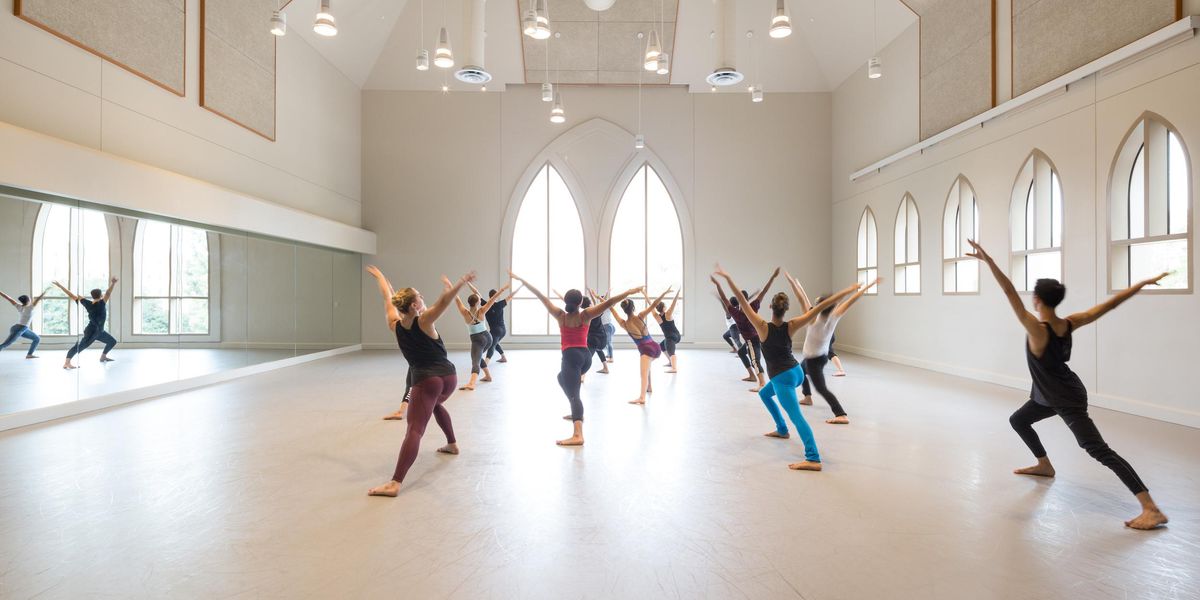The Latest: Postmodern Muses & More
Jaqlin Medlock and Barrington Hinds. Photo by Yi-Chun Wu, Courtesy Stephen Petronio Company.
Looking back over the 30 years of works he’s created for his company, Stephen Petronio has been thinking about the seminal dance artists he is passionate about. Merce Cunningham is one of them: When watching RainForest (1968) during Merce Cunningham Dance Company’s farewell tour, he was struck by the synergy of the dancing and the design—Andy Warhol’s floating silver pillows.
“It was one of the most weirdly magical epiphanies of dance and visual arts I’d ever seen,” he says. “The spare movement and the crazy pillows—they had a life of their own—seemed so apt for a dance performance. The poignancy of the way the dance and set interacted was shocking.”
This month, Petronio will launch an initiative called Bloodlines, in which his company will reconstruct a major postmodern work each season. The project, to honor the choreographers that inspired his own work and show audiences his lineage, is a five-year pilot program. To kick it off, Stephen Petronio Company will perform RainForest during its anniversary program at The Joyce Theater, April 7–12, along with his own Locomotor/Non Locomotor.
Coming into the dance world through contact improvisation and having danced for Trisha Brown in the ’80s, Petronio was not overly fond of Cunningham’s work when he first saw it. “I thought Cunningham technique was the antithesis of the quality I was interested in. It was more balletic; it was stiff and held. Years later, it hit me that the physicality was just part of it. It was the mental space of the stage that blew me away.”
Meg Harper, who danced with Cunningham from 1968 to 1977, staged RainForest for SPC along with Andrea Weber and Rashaun Mitchell, who were both with the company during its final eight years. Mastering the style has been a challenge for Petronio’s dancers. “In Merce’s work the pelvis is directed like a headlight,” Petronio says. “I’m much more spherical and rolling. We don’t hold lines very much, so this is a gigantic difference.” Next year, Petronio hopes to have his company perform Trisha Brown’s Glacial Decoy, and in the future, a solo by Anna Halprin and other Cunningham and Brown works.
It seems to be a time for honoring modern dance’s elders. Paul Taylor’s American Modern Dance presented the Limón Dance Company in a Doris Humphrey masterwork last month, and Pascal Rioult’s company performed reconstructions of works by Martha Graham and May O’Donnell last year. The heritage of modern dance goes far back. Not as far back as ballet, but it’s a time-honored American tradition, as diverse as America itself.
BalletX is one of many companies that Dance/UP has helped. Photo by Bill Herbert, Courtesy BalletX.
Dance/UP Shuts Down
Change is in store for the Philadelphia dance community: In November, Dance/UP, a regional branch of Dance/USA that offers a range of resources to Philly dance artists, announced that it was closing. The William Penn Foundation, which had funded Dance/UP each year since its inception in 2007, would no longer sponsor the organization.
Soon after, the foundation granted Dance/UP $89,000 in transitional funding. Since then, the staff has worked toward ensuring its key services continue after the organization closes at the end of March. They hope programs like the grant deadlines e-blast and portable dance floor rentals can continue through other institutions. “Dance service organizations have closed their doors and new ones have reopened all across the company,” says Dance/USA executive director Amy Fitterer. “Something will emerge. People will come together to share information and resources. It reminds dance artists that if they want a community-based organization, they have to be a part of it.”
Desert Dancer
Akram Khan working on a duet. Courtesy Relativity Studios.
Based on real events, Desert Dancer, a film with choreography by Akram Khan, tells the story of an underground dance company with potentially dire consequences. It’s 2009, in the midst of a politically unstable presidential election in Iran, and a young Afshin Ghaffarian is determined to dance—despite a law that forbids citizens from doing so. Self-taught, he watches online videos of Michael Jackson, Pina Bausch, Gene Kelly and Rudolf Nureyev. Opens April 10 nationwide.
Côté leading an NBoC rehearsal. Photo by Aaron Vincent Elkaim, Courtesy NBoC.
In the Works: Le Petit Prince
These days, everyone wants a piece of the multitalented dancer-choreographer-director Guillaume Côté. In addition to giving outstanding performances at the National Ballet of Canada, he’s become artistic director of this summer’s Festival des Arts de Saint Sauveur in Québec. As choreographic associate at NBoC, he’s also busy creating his first full-length for the company: Le Petit Prince, to premiere during the 2015–16 season, will be an adaptation of Antoine de Saint-Exupéry’s whimsical 1943 novella about a stranded pilot’s encounter with a young prince who has fallen from space.




